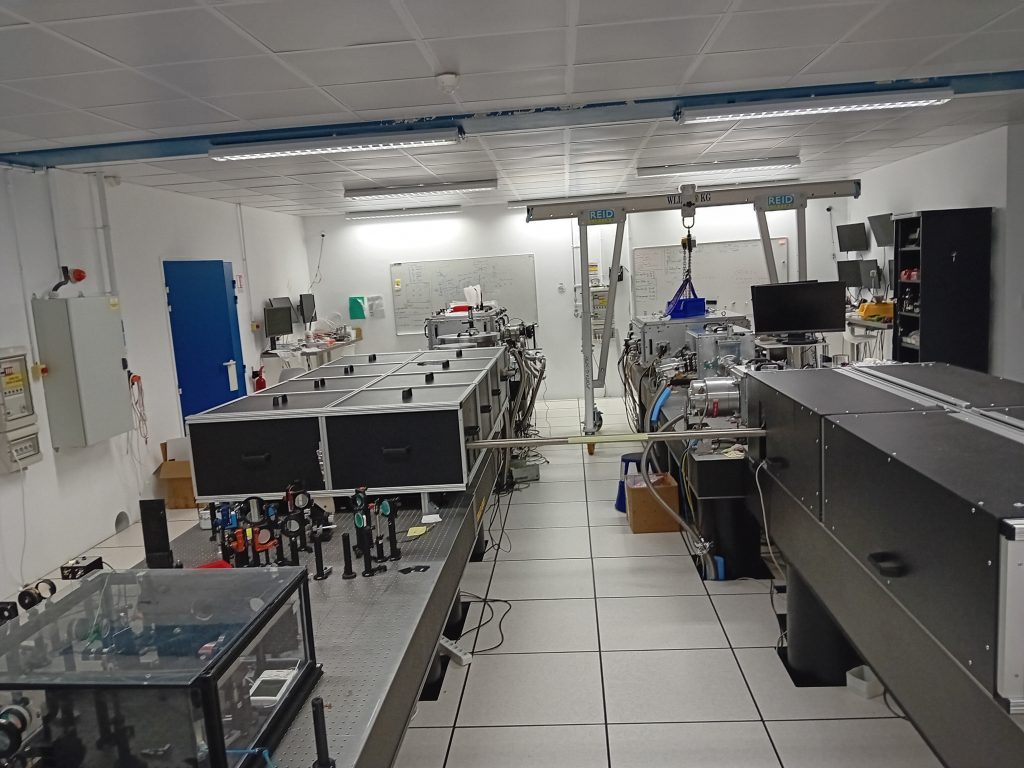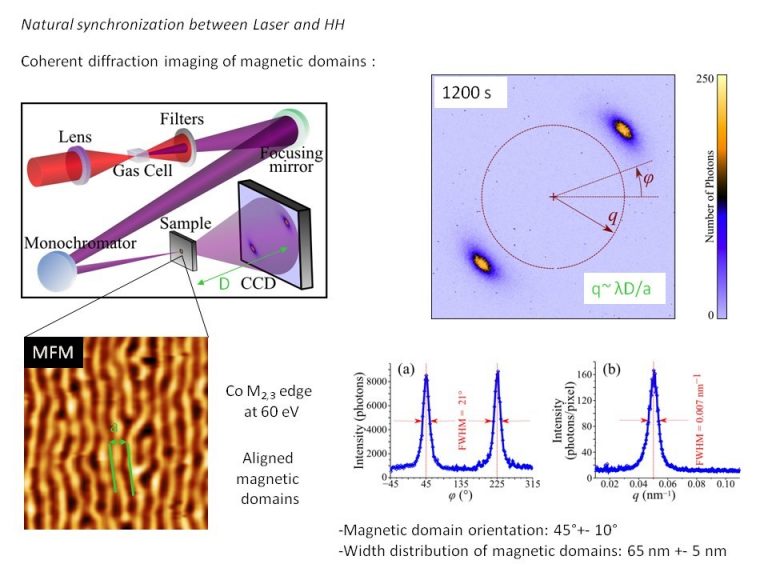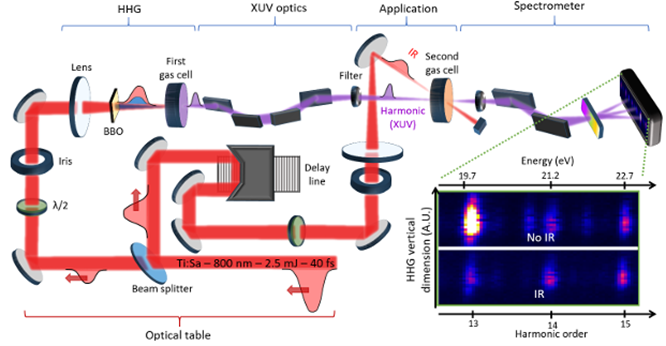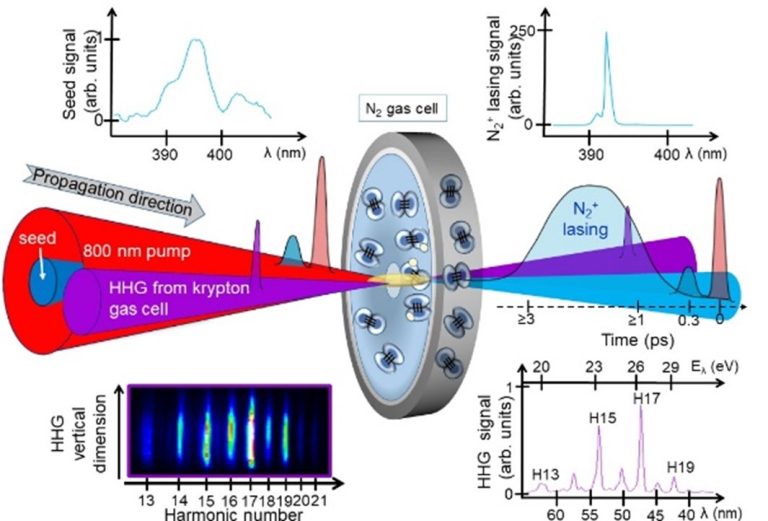Development and application of high-order harmonic sources
The research theme related to the sources of XUV (extreme ultraviolet) radiation is divided into fundamental studies on the source, mainly related to the quality of the beams, and their applications. The latter topic includes research on the injection of XUV ray amplifiers (laser-pumped or free-electron lasers), ultrafast magnetism, as well as work in XUV optics and XUV metrology. The studies are carried out in a dedicated room containing two experimental areas, also called beamlines, specialized in specific applications.
All the experiments take place in the so-called Coral Room, whose particularity compared to the other rooms of the laboratory is the presence of XUV beamlines (X-rays that are very not very penetrating and therefore not dangerous) generated by femtosecond infrared (IR) lasers. One of these lines, open to both laboratory and external researchers, is very versatile with the possibility of carrying out complex experiments called IR/IR, IR/XUV and XUV/XUV pump-probe at high temporal resolution (a few femtoseconds), thanks in particular to the high repetition rate of the sources, 4 kHz and the stability of the environment.

Our group studies the harmonics generated by focusing an intense femtosecond laser in a noble gas. This produces a train of attosecond pulses (1 as = 10-18 s) characterized by a discrete spectrum of harmonics extending from UV to X. Many parameters make it possible to optimize the emission of harmonics such as the pressure of the gas, the duration of the laser, its spatial distribution around the focus and even the use of magnets.

Femto-magnetism probed by high-order harmonics:
In collaboration with J. Lünning’s group at the LCPMR, we initiated the study of femtosecond magnetism thanks to so-called pump-probe experiments in which an infrared laser induces the demagnetization of a material which is then probed by a harmonic pulse. The results presented below were obtained with B. Vodungbo and J. Lünning of the LCPMR .
In 2011, we demonstrated that it was possible to probe a nano-structured magnetic system by coherent diffraction of high-order harmonics. [Boris Vodungbo, et al., Optics Express, 19, 5, 4346 (2011)]. To achieve this demonstration, we developed an original system for controlling harmonic polarization [Boris Vodungbo, et al., Optics Express, 19, 5, 4346 (2011)]

In 2012, we performed the first ultra-fast demagnetization experiment probed by high-order harmonics. [Boris Vodungbo, et al., Nature Communication, 3, 999, (2012)]
In 2015, we succeeded in circularly polarizing high-order harmonics and using for the first time the basic technique for studying magnetism, called XMCD, based on magnetic circular dichroism in the XUV. This represents a preciput for soft X-ray holography experiments to probe nano-structured magnetic systems [G. Lambert et al., Nature Communication, 6, 6167 (2015)].
In 2018, we continued the 2015 study using two linearly polarized laser beams to produce the high-order harmonics [B. Mahieu et al., Physical Review A, 97, 4, 043857 (2018)].
In 2020, we showed that ultrafast magnetism could be measured with a new technique based on Faraday rotation in the XUV. This complex technique measures the magnetic effect through the change in the polarization of harmonics and has the advantage of directly measuring the magnetic properties of samples by transmission [C. Alves et al., Phys. Rev. B 100(14), 144421 (2020)].
In 2022, we observed, by coherent diffraction, on bi-element samples such as CoPt (also on CoNi in 2023) that the instant corresponding to the beginning of the demagnetization of Co is delayed with respect to Platinum (likewise Cobalt with respect to Nickel) by 10 to 30 fs, this information giving new avenues for the understanding of the first moments of the phenomenon studied [M.Hennes et al., Applied Phys. Lett. 120 (7), (2022)].
In 2023, we observed, again by coherent diffraction, several unexpected results on single element samples of Fe(N): classical ultrafast demagnetization can be observed very far from the magnetic threshold of the element, but remains weaker and takes longer to take place.

XUV Beam Time Metrology:
In 2024, thanks to the study of the measurement of harmonic absorption in the XUV of an ionized gas by an IR laser pump, we showed that it was possible to measure the amplitude and duration at mid-height of the IR pulse or femtosecond XUV. Also, using an XUV spectrometer and thanks to the development of an iterative algorithm, we were able to find the temporal and spectral phases. It is therefore now possible, through this phenomenon of transient absorption, to completely characterize femtosecond XUV pulses. We have named this technique, TIBETAN FOX for: mulTIphoton aBsorption spEcTroscopy in gAses aNd a Frequency resolved cross cOrrelation in XUV.

Study of the laser effect in nitrogen:
Between 2020 and 2023, as part of a multi-year collaboration with the FILM group of the LOA, we built and carried out numerous experiments to validate the so-called V-shaped model of lasaging at 391 nm without population inversion in an ionized nitrogen gaseous plasma. The idea was to probe the dynamics of 3 levels of the ionized molecule N2+ related to laser amplification. The coincidence of certain harmonics with the levels considered made it possible to use them in the absorption regime. This result, which brings to an end more than 10 years of debate on the subject, also gives hope for the development of all-optical lasers in X-rays and gamma rays, for which population inversion is complex.

X-ray optics and soft X-ray beam metrology:
The high-order harmonics source has several qualities that make it particularly attractive for XUV optics studies and XUV metrology. The beam is collimated, polarized and contains many wavelengths that can be used together, for example to study optics associated with attosecond beams, or separately using a monochromatization system. The wavefront is most often of very good quality, easily reaching lambda/7 RMS and lambda/20 RMS after optimization. Finally, and this is an important criterion, the system is very compact and very flexible. Thus, we have demonstrated that it is possible, and quite simple, to modify the parameters of the XUV beam by playing with those of the infrared laser of creation.
In 2003, thanks to a collaboration with P. Balcou, we started the use of high-order harmonics in XUV metrology. [C. Valentin et al, Opt. Lett, 28, 12, June 2003.; S. Kazamias et al, Eur. Phys. J. D, 26, p47-50 (2003)]
Between 2003 and 2017, thanks to a collaboration with the company Imagine Optic, the first Hartmann-type wavefront sensor (with a hole plate) was realized and demonstrated exceptional measurement accuracy. [P. Mercère et al., Opt. Lett., 28, 17, 1534 (2003)]. This sensor has been improved and used on many soft X-ray experiments ranging from high-order harmonics, to injected XUV lasers and free-electron lasers [R. Bachelard et al, Phys. Rev. Lett. 106, 234801 (2011)). The sensor has also been used regularly for manual optimization [H. Coudert-Alteirac Appl. Sci., 7, 11, 1159 (2017); Mabel Ruiz-Lopez et al, Sensors, 20, 22, 6426; (2020)] or automatic [P. Mercère et al, Optics Letters, 31, 2, 2006] of XUV focusing mirrors.
In 2005 and 2006, we produced the first so-called “chirped” mirrors that make it possible to compress an attosecond XUV pulse. [A. S. Morlens at al., Opt. Lett., 30, 12, June 2005; A. S. Morlens at al., Optics Letters, 31, No. 10 / 1558 (2006)]
In 2006, we started studies on XUV holography using a bundle of high-order harmonics. This study was completed in 2015 by the first demonstration of multi-spectral soft X-ray holography applicable to attosecond beams. [G. Williams et al., Opt. Lett. 40, 13, 3205-3208 (2015)]
Between 2007 and 2021, we started work that continues to this day on the coherent control of the wavefront of high-order harmonics by modifying the wavefront of the incident laser. [C. Valentin, et al, J. Opt. Soc. Am. B, 25, 7, B161(2008); J. Gauthier et al., Eur. Phys. Day. D, 48, 3, 459-463 (2008); S. Künzel et al., Applied Optics, 54, 15, 4745-4749 (2015); J. Koliyadu et al., Photonics, 4, 2, 25 (2016); H. Dacasa et al., Optics Express, 27, 3, 2656-2670 (2019); O. de La Rochefoucauld, Sensors 21, 3, 874 (2021)]
In 2020, we developed and characterized a wavefront sensor suitable for very open XUV beams [Lu Li et al, Optics Letters, 45, 15, 4248-4251 (2020)]. This is a first step in the production of sensors for optical metrology or steppers for EUV lithography.


